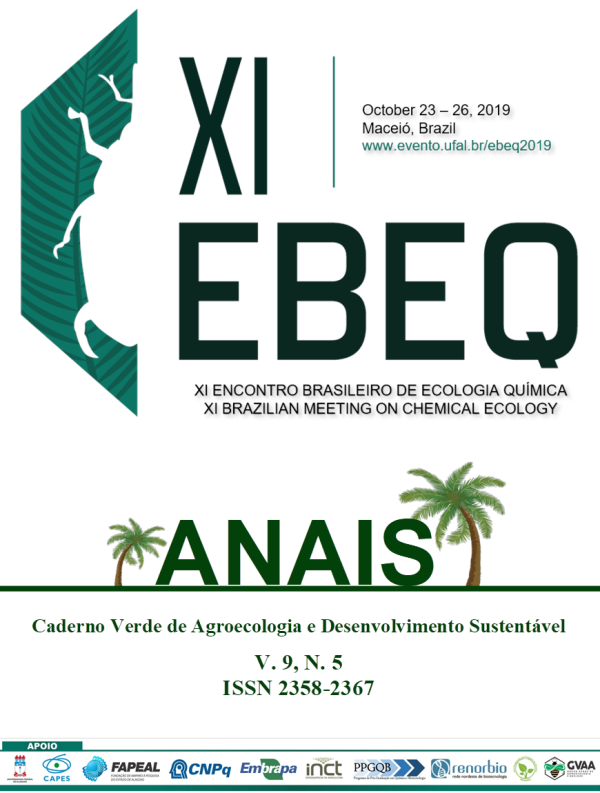SPIROS ARE EVERYWHERE
Palavras-chave:
BICYCLIC ACETALS / KETALS, MASS SPECTROMERTRY, BIOLOGICAL ACTIVITY.Resumo
Dihydroxyketones (ketodiols), bearing the two hydroxy groups on either side of the carbonyl group may form bicyclic products (spiroacetals = spiroketals - see sketch: X and Y = 1,2, or 3) upon intramolecular cyclisation. So far, five different systems have been found in nature: compounds showing two 5- to 7-membered rings and mixed structures. In two cases, spiros carry a double bond in one of the rings. Apart of very few exceptions, the carbon skeletons of these volatiles are unbranched, indicating an origin from the acetate pool. Because of the anomeric effect, caused by the two oxygens adjacent to the spiro center, the thermodynamical stability of the possible diastereomers is different, and therefore, the natural products may show very different proportions. Compound A (see sketch) usually co-occurs with B, C, and D, however, amounts of D do not exceed 1-2% of that of A. In contrast, E and F, which may be associated with A-D, usually occur in a relation of about 1:1. Reasons will be discussed. It should be noted that the natural mixtures do not show the thermodynamically most stable composition of stereoisomers. For structure elucidation of natural spiros, it is important to understand the principles of their mass spectrometric fragmentation. Showing a multitude of biological activities, spiros are widespread in nature and have been found in microorganisms, plants (flower volatiles), and animals (insects, mammals).Downloads
Publicado
Como Citar
Edição
Seção
Licença
Termo de cessão de direitos autorias
Esta é uma revista de acesso livre, em que, utiliza o termo de cessão seguindo a lei nº 9.610/1998, que altera, atualiza e consolida a legislação sobre direitos autorais no Brasil.
O(s) autor(es) doravante designado(s) CEDENTE, por meio desta, publica a OBRA no Caderno Verde de Agroecologia e Desenvolvimento Sustentável, representada pelo Grupo Verde de Agroecologia e Abelhas (GVAA), estabelecida na Rua Vicente Alves da Silva, 101, Bairro Petrópolis, Cidade de Pombal, Paraíba, Brasil. Caixa Postal 54 CEP 58840-000 doravante designada CESSIONÁRIA, nas condições descritas a seguir:
O CEDENTE declara que é (são) autor(es) e titular(es) da propriedade dos direitos autorais da OBRA submetida.
O CEDENTE declara que a OBRA não infringe direitos autorais e/ou outros direitos de propriedade de terceiros, que a divulgação de imagens (caso as mesmas existam) foi autorizada e que assume integral responsabilidade moral e/ou patrimonial, pelo seu conteúdo, perante terceiros.
O CEDENTE mantêm os direitos autorais e concedem à revista o direito de divulgação da OBRA, com o trabalho simultaneamente licenciado sob a Licença Creative Commons do tipo atribuição CC-BY.
O CEDENTE têm autorização para distribuição não-exclusiva da versão do trabalho publicada nesta revista.
O CEDENTE têm permissão e são estimulados a publicar e distribuir seu trabalho online (ex.: em repositórios institucionais ou na sua página pessoal) a qualquer ponto antes ou durante o processo editorial, já que isso pode gerar alterações produtivas, bem como aumentar o impacto e a citação do trabalho publicado.










